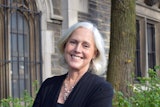The basic facts Rebecca Skloot writes about are these: Henrietta Lacks grew up poor, orphaned and hard-working, even as a child, on her grandfather’s tobacco farm in rural Halifax County, Va. She died a painful death in 1951 at age 31 as the result of cancerous tumor on her cervix. She left to mourn her a husband, five young children, other kin and loyal friends who loved her. She is buried in an unmarked grave in her hometown of Clover, Va.
Not long before she died, doctors took a sample from her tumor before doing a procedure to treat it and gave them to a researcher, Dr. George Gey. His lab regularly harvested samples this way to find human cells that would live in cell culture — so-called immortal cells — in a quest for a cancer cure.
A lab assistant labeled each vial with the first two letters of the unwitting donor’s first and last names. None had ever survived anyway. Henrietta’s did. Before her death, the sample marked “HeLa” multiplied and continued to do so repeatedly— so much so that the offspring are alive today. They are responsible for the polio vaccine and breakthroughs that led to cancer treatments, in vitro fertilization, cloning, gene mapping, cornea transplants and numerous other medical miracles.
People have made millions of dollars from HeLa cells and Lacks’ family has received nothing. Many scientists and doctors all over the world knew about them and had worked with them, but her husband and children did not know the cells existed until more than 20 years after Lacks died. A daughter-in-law heard about them by chance when she met a cancer researcher at a friend’s home. (One source reports second-handedly that Gey told Henrietta, basically on her deathbed, about her multiplying cells and the wonders they might produce some day.)
The release of this book has generated a great deal of media buzz and commentary, most of it focused on the ethics of taking human cells without consent and profiting from them without compensating the donor or family. Commentators also lamented the exploitation of Black people in medical experiments they likened to the Tuskegee syphilis studies, though there are distinctions between the cases. No one stood by and watched Lacks die without treating her, as far as we know. Lacks died in the colored ward of Johns Hopkins Hospital, the only one around that would treat Blacks then and one of the best in the country.
The ethical issues are of the utmost importance, of course, but what seems to be missing from the discussion so far is the human element that goes to the heart of this book and the writer’s apparent intent. As a teenager in the Pacific Northwest, Skloot learned of HeLa’s role in science from a teacher, who mentioned Lacks’ name and, as an afterthought, that the HeLa donor was a Black woman. (Skloot describes herself as White and half-Jewish.) Her curiosity was piqued briefly. She went on to study biology in college and often came across the HeLa cell phenomenon, but Lacks’ name never came up again.
From time to time, Skloot still wondered about her. As the Internet came into play, she searched for any bit of information about her and eventually stumbled across articles in Ebony and Jet about the Lacks family. By the time she went to graduate school to study writing, she “had the idea that I’d write a book that was a biography of both the cells and the woman they came from — someone’s daughter, wife and mother.”
It took 10 years, but that is what she did. In a book that reads more like a good detective mystery novel than a book about science, she peels off layers to reveal a complicated, pretty woman with style and a big heart. She grew up, married a cousin and lived the life of a steel-mill worker’s wife in the Baltimore area. To learn even that, Skloot had to face a skeptical family who hung up on her, stood her up and evaded questions before cooperating and ultimately befriending her.
Skloot tells it straight, but sensitively in that she seems to gets the language and the cultural nuances right when dealing with country people from another era and race. Neither does she mince words about the liberties that experts took in research on colored patients and their use of human tissue as a commodity. The author interweaves the Lacks story with details from the medical records and about the science the HeLa cells made possible. Skloot is an award-winning science writer and teacher of writing at the University of Memphis.
In making Henrietta real and human, she explores the ethics of research and asks such questions as; why should others profit from the product of one woman’s body while her own family can ill afford health care? Why are her relatives and many other African-Americans terrified of seeking medical care for fear of becoming lab experiments? It is also a wake-up call to Blacks to learn more about medical science and to be ever vigilant when we or someone we love is in need of care.
















